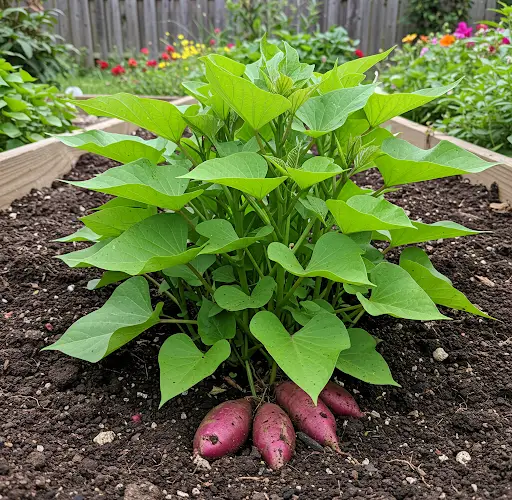I Wish I Knew About These Sweet Potato Growing Methods Sooner – The Tubers Are Large and Sweet!
Sweet potatoes are a delicious, nutrient-rich crop that is surprisingly easy to grow, provided you use the right methods. Many gardeners struggle with small, stunted tubers, not realizing that a few simple techniques can make a world of difference. If you want to grow large, sweet, and high-yielding sweet potatoes, this guide will show you the most effective growing methods, including container gardening, raised beds, and vertical stacking. With these techniques, you can maximize space and improve the quality of your harvest.
Why Grow Sweet Potatoes?
Sweet potatoes are not only delicious and versatile in the kitchen, but they also have several advantages for home gardeners:
- Nutrient-rich: High in vitamins A and C, fiber, and antioxidants.
- Low maintenance: Once established, they require minimal care.
- Productive: A single plant can yield multiple large tubers.
- Adaptable: Can be grown in different soil types and climates.
- Space-saving options: Can be grown in containers or vertically if you have limited space.
Best Methods for Growing Large and Sweet Sweet Potatoes
1. Raised Bed Method – Loose Soil for Maximum Growth
One of the biggest secrets to growing large sweet potatoes is loose, well-draining soil. Traditional in-ground planting often results in tubers struggling to expand due to compacted soil. Raised beds solve this issue.
How to Grow Sweet Potatoes in Raised Beds:
- Build a Raised Bed: Use wooden planks or bricks to create a bed at least 12–18 inches deep.
- Prepare the Soil: Use a loose, sandy, and well-draining mix with compost for nutrients.
- Plant Slips (Sprouts): Space them about 12 inches apart in rows.
- Water Consistently: Keep the soil moist, especially in the early growing stages.
- Mulch to Retain Moisture: Use straw or grass clippings to keep the soil temperature stable.
- Harvesting: After about 100–120 days, dig carefully with a fork to avoid bruising the tubers.
🔹 Tip: Avoid nitrogen-rich fertilizers, as they promote leaf growth over tuber formation.
2. Container Gardening – Perfect for Small Spaces
If you lack garden space, growing sweet potatoes in large containers or grow bags is an excellent option. Containers allow better control over soil quality, drainage, and pest management.
How to Grow Sweet Potatoes in Containers:
- Choose a Large Container: At least 20 inches deep and 15 inches wide.
- Use Well-Draining Soil: A mix of potting soil, sand, and compost works best.
- Plant the Slips: Bury the bottom leaves and ensure proper spacing.
- Water Regularly: Keep the soil moist but avoid overwatering.
- Provide Sunlight: Place the container in a full-sun location (6-8 hours daily).
- Support Vertical Growth: Use a trellis if vines become too long.
- Harvesting: When leaves start yellowing after 3–4 months, check for mature tubers.
🔹 Tip: Containers dry out faster than ground soil, so check moisture levels frequently.
3. Vertical Stacking – Maximizing Yield in Limited Space
For those who love innovative gardening, the stacked tire or tower method is an excellent way to grow sweet potatoes vertically. This method maximizes space while allowing easy access to your harvest.
How to Grow Sweet Potatoes Using the Stacking Method:
- Gather Old Tires or Stacking Buckets: Place them on well-draining soil.
- Fill the Bottom Layer: Use loose, sandy soil mixed with compost.
- Plant Sweet Potato Slips: Space them evenly around the base.
- Add More Layers: As vines grow, add another tire/bucket layer and fill it with soil.
- Water Thoroughly: Keep the soil consistently moist but not waterlogged.
- Monitor Growth: Once vines begin yellowing (after 100–120 days), harvest by removing the layers one by one.
🔹 Tip: This method is also great for protecting tubers from pests like rodents and insects.
4. Trench Method – Traditional Yet Effective
The trench method is a more conventional way to grow sweet potatoes but remains one of the most effective if you have the space.
Steps for the Trench Method:
- Dig Trenches: Make rows about 12 inches deep and 3 feet apart.
- Prepare the Soil: Fill the trenches with loose, well-draining compost-rich soil.
- Plant the Slips: Space each slip at least 12 inches apart.
- Water Deeply: Maintain consistent moisture without waterlogging.
- Hilling: As the plants grow, add more soil around the base to encourage tuber formation.
- Harvest: Use a fork to gently dig up the tubers after 3-4 months.
🔹 Tip: Hilling every few weeks ensures tubers have enough room to expand.
Caring for Your Sweet Potato Plants
No matter which method you choose, proper care is essential to ensure healthy, large, and sweet tubers.
✅ Essential Growing Tips:
✔ Sunlight: Full sun (6-8 hours daily) ensures optimal growth. ✔ Soil Quality: Loose, sandy, and nutrient-rich soil promotes larger tubers. ✔ Watering: Regular watering, especially in the early weeks. ✔ Pest Control: Watch for aphids, weevils, and rodents. Use organic repellents if needed. ✔ Fertilization: Use potassium-rich fertilizers for better tuber development. ✔ Curing for Sweetness: After harvesting, cure sweet potatoes for 7-10 days in a warm, humid place to enhance sweetness.
Final Thoughts
Growing large and sweet sweet potatoes is easier than many think—you just need the right method! Whether you choose raised beds, containers, vertical stacking, or trench planting, your plants will thrive with proper soil, sunlight, and watering.
If you’ve been struggling with small, tasteless tubers, try one of these methods and see the difference for yourself. With just a little effort, you’ll soon be harvesting an abundance of delicious, homegrown sweet potatoes!
🌱 Happy Gardening! 🌱



